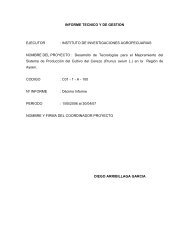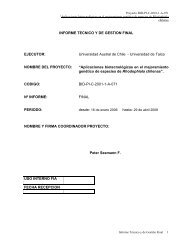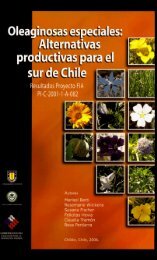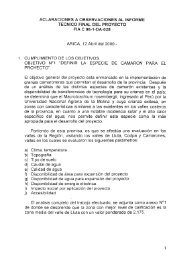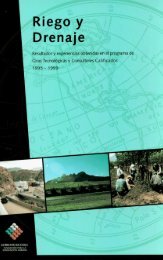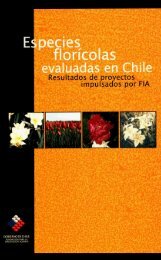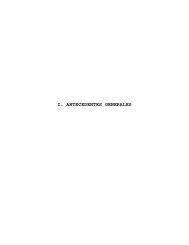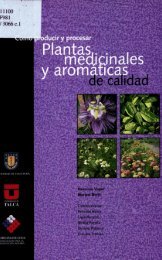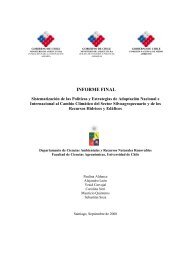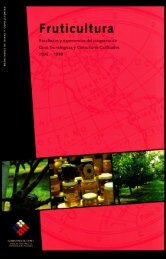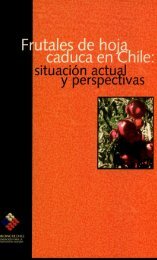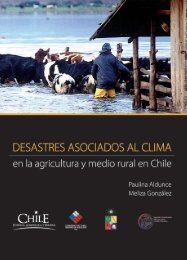Los residuos agrÃcolas y su uso en la alimentación de rumiantes
Los residuos agrÃcolas y su uso en la alimentación de rumiantes
Los residuos agrÃcolas y su uso en la alimentación de rumiantes
You also want an ePaper? Increase the reach of your titles
YUMPU automatically turns print PDFs into web optimized ePapers that Google loves.
LOS RESIDUOS AGR[COLAS Y SU US0 EN LA ALIMENTAC16N DE RUMIANTES / CapitUlO 1<br />
Este residuo pue<strong>de</strong> usarse con pastoreo directo, como soiling o <strong>en</strong>si<strong>la</strong>do para us0 posterior.<br />
En este ljltimo cas0 se <strong>de</strong>be t<strong>en</strong>er <strong>en</strong> cu<strong>en</strong>ta que por el alto cont<strong>en</strong>ido <strong>de</strong> proteina<br />
podrian <strong>de</strong>sarrol<strong>la</strong>rse ferm<strong>en</strong>taciones anormales, que afectarian el con<strong>su</strong>mo por parte<br />
<strong>de</strong> 10s animales. Su inclusi6n <strong>en</strong> dietas para <strong>rumiantes</strong> se justifica principalm<strong>en</strong>te <strong>en</strong><br />
bovinos <strong>de</strong> carne para cualquiera <strong>de</strong> <strong>su</strong>s categorias, especialm<strong>en</strong>te <strong>en</strong> terneros reci<strong>en</strong><br />
<strong>de</strong>stetados o <strong>en</strong> novillos <strong>de</strong> crianza, ya que <strong>su</strong> nivel <strong>de</strong> proteina permite abastecer el<br />
total <strong>de</strong> 10s requerimi<strong>en</strong>tos proteicos <strong>de</strong> estos animales. En novillos <strong>en</strong> <strong>la</strong> etapa <strong>de</strong> <strong>en</strong>gorda,<br />
<strong>de</strong>be incluirse <strong>en</strong> m<strong>en</strong>or porc<strong>en</strong>taje <strong>de</strong> <strong>la</strong> raci6n total y <strong>su</strong>plem<strong>en</strong>tar con algljn<br />
grano o fu<strong>en</strong>te <strong>en</strong>ergbtica para comp<strong>en</strong>sar el m<strong>en</strong>or aporte <strong>de</strong> <strong>en</strong>ergia. En el cas0 <strong>de</strong><br />
vacas lecheras, s610 se recorni<strong>en</strong>da<strong>su</strong> us0 <strong>en</strong> aquel<strong>la</strong>s <strong>de</strong> producciones medias a bajas<br />
o durante <strong>la</strong> etapa <strong>de</strong> ljltimo tercio <strong>de</strong> gestaci6n. Este criterio es vdlido tambibn para<br />
cabras lecheras <strong>en</strong> el period0 <strong>de</strong> maxima producci6n.<br />
1.6.3.2 Residuo <strong>de</strong> cultivo <strong>de</strong>l apio (Apium graveol<strong>en</strong>s L. var, Dulce)<br />
Este cultivo se <strong>de</strong>sarrol<strong>la</strong> principalrn<strong>en</strong>te <strong>en</strong> <strong>la</strong>s Regiones IV, V, VI y Metropolitana,<br />
distribuykndose mayoritariam<strong>en</strong>te <strong>en</strong> <strong>la</strong> Regi6n Metropolitana y <strong>en</strong> <strong>la</strong> V Regi6n. El resi-<br />
duo se compone principalm<strong>en</strong>te <strong>de</strong> 10s tallos basales con <strong>su</strong>s hojas y <strong>la</strong> corona, que es<br />
lo que queda <strong>en</strong> el <strong>su</strong>elo <strong>de</strong>spubs <strong>de</strong> <strong>la</strong> cosecha.<br />
La produccibn <strong>de</strong> biomasa total medida <strong>en</strong> difer<strong>en</strong>tes cultivares (Mantero<strong>la</strong> y Cerda,<br />
1990) alcanza a 105,8 ton <strong>de</strong> MV/ha, equival<strong>en</strong>te a 6,6 ton <strong>de</strong> MS/hB. Despues <strong>de</strong> <strong>la</strong> cose-<br />
cha, queda una biomasa residual <strong>en</strong>tre 30-40 ton <strong>de</strong> MV/hB, equival<strong>en</strong>te a 2,5-3,8 ton <strong>de</strong><br />
MS/ha. En dicho residuo <strong>la</strong>s hojas aportan el 52%, 10s tallos el 36% y <strong>la</strong>s coronas el 12%.<br />
Este residuo pres<strong>en</strong>ta un bu<strong>en</strong> valor nutritivo caracterizado por niveles medios <strong>de</strong> pro-<br />
teina, bajo cont<strong>en</strong>ido <strong>de</strong> pared celu<strong>la</strong>r y altas digestibilida<strong>de</strong>s, sin embargo conti<strong>en</strong>e<br />
altos porc<strong>en</strong>tajes <strong>de</strong> agua y <strong>de</strong> c<strong>en</strong>izas (Cuadro 1.20).<br />
Cuadro 1.20<br />
Valor nutritivo <strong>de</strong> 10s compon<strong>en</strong>tes <strong>de</strong>l residuo <strong>de</strong> cultivo <strong>de</strong> apio<br />
--*- CARACTERIS_T!CA-~ ~I TA_LILO-<br />
HOJAS I - -.-CORONAS"""__-""*--"-"._<br />
Materia seca (%) 10,5 930 12,o 1<br />
Materia orghnica (%) 567 632 56,6<br />
i<br />
I<br />
C<strong>en</strong>izas (%) 36,5 29,8 37,4<br />
Proteina bruta (%) 10,7 14,Q 997 I<br />
Pared ceiu<strong>la</strong>r (FDN) (Yo) 3090 25,l 3090 1<br />
Digestibilidad MS (%) 83,5 84,6 78,3<br />
Fu<strong>en</strong>te: Mantero<strong>la</strong> at al. (1993).<br />
F<br />
57




